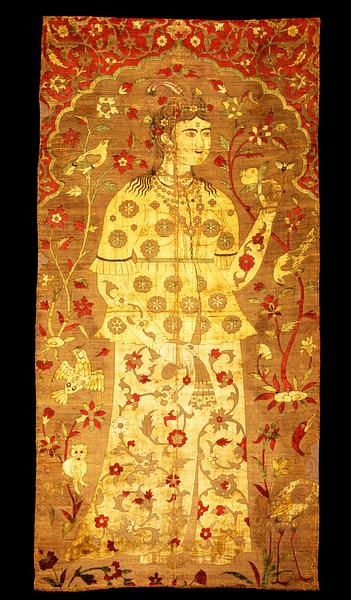Fløjlsbane af silke og silke omvundet med sølvlamel
Indien eller Iran; omkring 1600
H: 143; B: 69 cm
I sin størrelse og i sit ikke-gentagne mønster er denne monumentale skildring af en stående kvinde i en svejfet bue helt unik. Det var først og fremmest væverne fra det safavidiske Iran, der var kendte for at udføre disse teknisk set helt uovertrufne tekstiler, men i stormogulen Akbars biografi hævdes det, at inderne omkring 1600 var nået lige så langt i teknisk kunnen.
Farverne, buen, dragten, hårsmykket, ”kastemærket” og den relativt naturalistiske gengivelse af planter peger alle i retning af Indien som fremstillingssted.
Man må forestille sig, at dette tekstil sammen med andre beslægtede har prydet et fyrsteligt pragttelt.
Inv. nr. 37/1995
Publiceret i:
Phillips, London, 19/5-1995, lot 29;
Kjeld von Folsach: Kunst fra islams verden i Davids Samling, København 2001, kat.nr. 663;
Sheila S. Blair og Jonathan M. Bloom (red.): Cosmophilia. Islamic Art from the David Collection, Copenhagen, McMullen Museum of Art, Boston College, Boston 2006, kat.nr. 1;
Steven Cohen: “The use of fine goat hair for the production of luxury textiles: its origins and the similarities and differences of its use in Iran and India during the reigns of the Safavid and Mughal shahs” i Jon Thompson, Daniel Shaffer og Pirjetta Mildh (red.): Carpets and textiles in the Iranian world 1400-1700 : proceedings of the conference held at the Ashmolean Museum on 30-31 August 2003, Oxford 2010, s. 126, fig. 3;
Rahul Jain: Rapture: the art of Indian textiles, New Delhi 2011, kat.nr. 20, s. 68-69;
Steven Cohen: “Two outstanding Mughal qanat panels in the David Collection, with technical analyses and drawings of weaving structures by Anne-Marie Keblow Bernsted” i Journal of the David Collection, 4, 2014, s. 172, fig. 2 og s. 200-201, fig. 14;
Daniel C. Waugh: "The David Collection: Journal of the David Collection. 4," i The Silk road, 2014, 12, Featured museum, I: s. 132-136, fig. 5;
Louise W. Mackie: Symbols of power: luxury textiles from Islamic lands, 7th–21st century, Cleveland 2015, fig. 10.8, s. 416-417;
Sylvia Houghteling: The art of cloth in Mughal India, Princeton 2022, s. 181, fig. 4.23;
